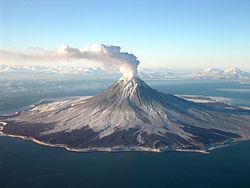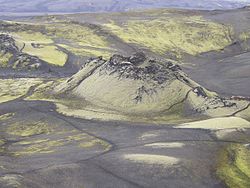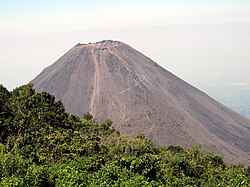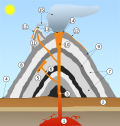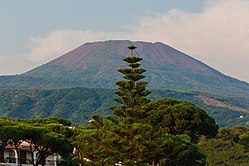Dormant volcano

Dormant volcanos are the volcanos that are quiet but might erupt again in the future.[1] If a volcano that has been silent for years erupts again or shows activity, it is called a "dormant volcano". Vesuvius of Italy is a prime example. After many years of dormancy, it re-emerged in 1931. Then it is dormant again. For example, Krakatoa in Indonesia, Aconcagua in Argentina, and Mount Fuji in Japan are dormant volcanoes.
Difficult to classify
It is difficult to distinguish active and inactive volcanos.
For example, some scientists have described Mount Fuji as dormant or inactive.[2] That volcano has been dormant since its last eruption in 1707,[3] but is also classified as active.[4] The Geological Survey of Japan lists Mount Fuji as among the active volcanoes on the island of Honshu.[5]
Mis-labelled as dormant or extinct
Some volcanoes may remain dormant for a long time; and an eruption is a surprise.
Before 79 AD, Vesuvius was considered dormant.
Before 1991, the Pinatubo volcano in the Philippines was labelled as dormant.
Before 1995, the Soufriere Hills volcano on the island of Montserrat was dormant.[6]
Before 1980, Mt. St. Helens in the United States was dormant.
Select list
There are many examples of volcanoes which are considered dormant.
- Mauna Kea in Hawaii,[7] the United States
- Mount Edziza in Canada[8]
- Mount Kilimanjaro in Tanzania
- Western Victorian Volcanic Plains in Australia[9]
- Trou aux Cerf in Mauritius
- Mount Hood in Oregon, the United States[2]
- Lake Toba in Indonesia
Dormant Volcano Media
Augustine Volcano (Alaska) during its eruptive phase on January 24, 2006
Video of lava agitating and bubbling in the volcanic eruption of Litli-Hrútur (Fagradalsfjall), Iceland, 2023
Lakagigar fissure vent in Iceland, the source of the major world climate alteration of 1783–84, has a chain of volcanic cones along its length.
Skjaldbreiður, a shield volcano whose name means "broad shield"
Izalco volcano, the youngest volcano in El Salvador. Izalco erupted almost continuously from 1770 (when it formed) to 1958, earning it the nickname of "Lighthouse of the Pacific".
- Cross-section through a stratovolcano (vertical scale is exaggerated):
Mt. Vesuvius, a stratovolcano, Gulf of Naples.
Lake Taupō, a volcanogenic lake in the caldera of Taupō supervolcano, New Zealand.
Timelapse of San Miguel (volcano) degassing in 2022. El Salvador is home to 20 Holocene volcanoes, 3 of which have erupted in last 100yrs
Related pages
References
- ↑ The plural of volcano can be either volcanos or volcanoes. Both are equally correct, and it is not a matter of British vs US spelling. Oxford English Dictionary. Spelling in any particular Simple page tries to be consistent.
- ↑ 2.0 2.1 Ball, Jessica. "Voices: Dead or alive ... or neither? Why a dormant volcano is not a dead one," Earth Magazine (American Geosciences Institute). September 8, 2010; retrieved 2012-6-14.
- ↑ Titsingh, Isaac. (1834). Annales des empereurs du japon, p. 416; Shizuoka University, 宝永四年(1707)噴火 Archived 2017-08-12 at the Wayback Machine; retrieved 2012-6-14.
- ↑ Britannica Online, "Mount Fuji"; retrieved 2012-6-14.
- ↑ Geological Survey of Japan, "Active Volcanoes in Japan"[dead link]
- ↑ "'Ladies and gentlemen, on your left you will see an erupting volcano': The stunning sight Caribbean holidaymakers saw from plane," Daily Mail (UK). 1 April 2010; retrieved 2012-6-14.
- ↑ University of Hawaii, Institute of Astronomy, "About Mauna Kea Observatories"; retrieved 2012-6-14.
- ↑ British Columbia Parks, "Mount Edziza Provincial Park"; retrieved 2012-6-15.
- ↑ University of Western Australia, "Volcanoes & Earthquakes in SE Australia," Archived 2012-06-11 at the Wayback Machine 2 December 2004; retrieved 2012-6-14.
